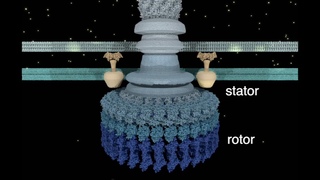The bacterial flagellar motor
The flagellar motor is nature’s version of the electric motor. It is found in the membrane of many bacterial species and turns a propellor-like structure called a flagellum, enabling the bacterium to swim. The motor is 45 nanometres in diameter, made out of thousands of proteins and can rotate at speeds in excess of 30,000 rpm with an efficiency close to 100%. So how does it work?
It is driven by ion-translocation across the membrane... during respiration/photosynthesis the bacterium pumps ions (H

















![[Eng. Subs][[MikuHatsune]] SaikinOsen - Bacterial Contamination - [3DPV]](https://sun9-1.userapi.com/ukbnxdZcShSkCAT7dhD6gkwe22Ivdio6n5Qo9A/dYtJkpYMSn4.jpg)





![Bacterial Husk - 2/25/17 [FULL SET]](https://sun9-16.userapi.com/53ffZEDJvI9vmdSpkllxxQl8kwhCsHUI7rqO_w/zvvD3DmSPiE.jpg)